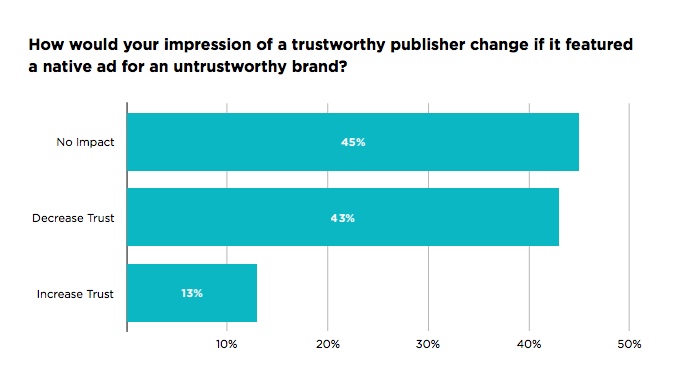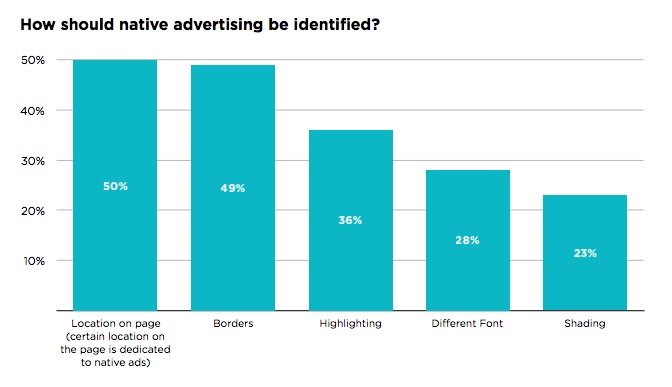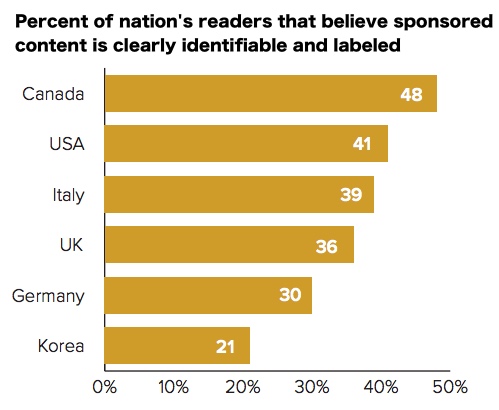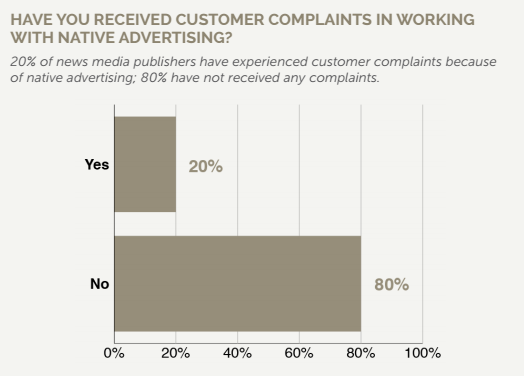
One of the true bright spots for publishers could wind up further eroding the value of their most precious asset.
With display advertising in a free fall — and what little of value there is being sucked up by Google and Facebook –publishers are increasingly turning to native advertising and sponsored content to earn meaningful revenue. The New York Times, for example, now earns nearly 20 percent of its digital revenue from its T Brand Studios.
The only problem is that sponsored content, despite being decades old as an concept, remains confusing to readers. They sometimes struggle to identify it, have mixed emotions about its being in the same place as regular editorial content, and often feel like publishers must be held to higher standards.
Here are five charts that illustrate the increased risks sponsored content poses to publishers, and what they’re doing about it.
Trust issues
While the wrong kinds of ads can diminish readers’ opinion of a publisher, this dynamic is especially pronounced when it comes to native ads and sponsored content. Nearly half of the respondents to a survey conducted by Contently, in partnership with the Tow-Knight Center for Entrepreneurial Journalism at CUNY and Radius Global Market Research, said a publisher that runs sponsored content produced for a brand readers distrust can wind up diminishing readers’ opinions of the publisher. The Atlantic took a nasty beating for running content sponsored by the Church of Scientology a few years ago, but that’s by no means the only example.

Keep it separate?
One of the biggest draws of native advertising is the real estate it occupies. As more and more content consumption happens inside feeds, either on publishers’ websites or on third-party platforms, advertisers are relishing the opportunity to integrate their messages into that flow.
Unfortunately for publishers, the public is divided on whether or not that’s a good thing, according to the study conducted by Contently, CUNY and Radius.

Label warning
That anxiety stems from a lot of readers feeling confused by what, exactly, sponsored content is. A majority of people surveyed do not believe that sponsored content is labeled clearly, according to research conducted by Reuters. This problem is even more acute in foreign countries.

Confusion breeds anger
That confusion, along with the other issues outlined above, has led a substantial percentage of readers to complain about the native ads publishers run. Research published in late October by the International News Media Association and the Native Advertising Institute found that a full fifth of news media publishers surveyed reported that they’d received complaints from their readers about native advertising.

Scrambling
Perhaps because of how sensitive readers can be, publishers have been scrambling to improve the transparency around what is sponsored and what is not on their sites. Many of them had a lot of ground to cover: A Mediaradar analysis published this spring indicated nearly three quarters of all publishers running sponsored content were doing so in a way that was not compliant with FTC regulations.
Barely six months later, that number has changed dramatically, according to a Mediaradar follow-up: A majority, or 61 percent, of publishers that run sponsored content now do it in a way that’s FTC-compliant.
More in Media

Meta AI rolls out several enhancements across apps and websites with its newest Llama 3
Meta AI, which first debuted in September, also got a number of updates including ways to search for real-time information through integrations with Google and Bing.

Walmart rolls out a self-serve, supplier-driven insights connector
The retail giant paired its insights unit Luminate with Walmart Connect to help suppliers optimize for customer consumption, just in time for the holidays, explained the company’s CRO Seth Dallaire.

Research Briefing: BuzzFeed pivots business to AI media and tech as publishers increase use of AI
In this week’s Digiday+ Research Briefing, we examine BuzzFeed’s plans to pivot the business to an AI-driven tech and media company, how marketers’ use of X and ad spending has dropped dramatically, and how agency executives are fed up with Meta’s ad platform bugs and overcharges, as seen in recent data from Digiday+ Research.








